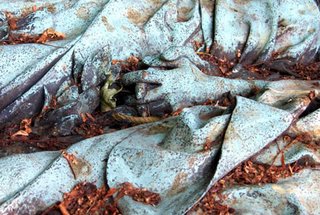Tomb of Croce-Spinelli and Sivel II

They died together in a ballooning accident at 26,000 feet over India: the air grew too thin and they were asphyxiated. In a "tribute to their comradeship in life and death," the "huge marble monument over the tomb that they share in Père Lachaise Cemetery portrays the men lying together side by side, hand in hand, presumably naked, but covered by a sculptured sheet from the waist down. There are flowers in their hands." The monument is one of the most talked-about in the Paris cemetery.
On April 15, 1875, three French scientists, Gaston Tissandier, Théodore Sivel, and his lover Joseph Croce-Spinelli, made and ascent in a balloon, "Le Zenith." The science of high-altitude flying was then in its infancy.
These three scientists had carefully collected all the information available to aid them in their experiment, and had rightly concluded that their balloon capacity was not sufficient to carry with them enough oxygen for the needs of their entire ascent.
They took along however, three bags of oxygen, which they agreed to use only when the need for it became absolutely imperative. Preparations having been completed, the balloon was released, and it rose rapidly.
Let us hear the story of the ascent as related by the only survivor, Tissandier:
"I now come to the fateful moments when we were overcome by the terrible action of reduced pressure (lack of oxygen). At 22,900 feet torpor had seized me. I wrote nevertheless, though I have no clear recollection of writing. We are rising. Croce is panting. Sivel shuts his eyes. Croce also shuts his eyes. At 24,600 feet the condition of torpor that overcomes one is extraordinary.
Body and mind become feebler. There is no suffering. On the contrary one feels an inward joy. There is no thought of the dangerous position; one rises and is glad to be rising. I soon felt myself so weak that I could not even turn my head to look at my companions. I wished to call out that we were now at 26,000, but my tongue was paralyzed. All at once I shut my eyes and fell down powerless and lost all further memory."
The balloon ascended to nearly 28,000 feet. When Tissandier regained consciousness, the balloon was falling rapidly; but his two companions were dead. The sole survivor of the expedition has pieced a fragmentary story of what happened together. Tissandier tells how as they rose to higher altitudes a feeling of buoyancy and exhilaration possessed them.
Although aware of their inability to function normally, they continued to release the ballast, and so rose even higher. When eventually convinced of the need for oxygen, Tissandier records that his arms were powerless and he was unable to raise the mouthpiece of the oxygen container to his lips. Though within easy reach, that which would have saved the lives of his companions went unused.
From: Mervyn G. Hardinge, Signs of the Times, May 30, 1950


0 Comments:
Post a Comment
<< Home